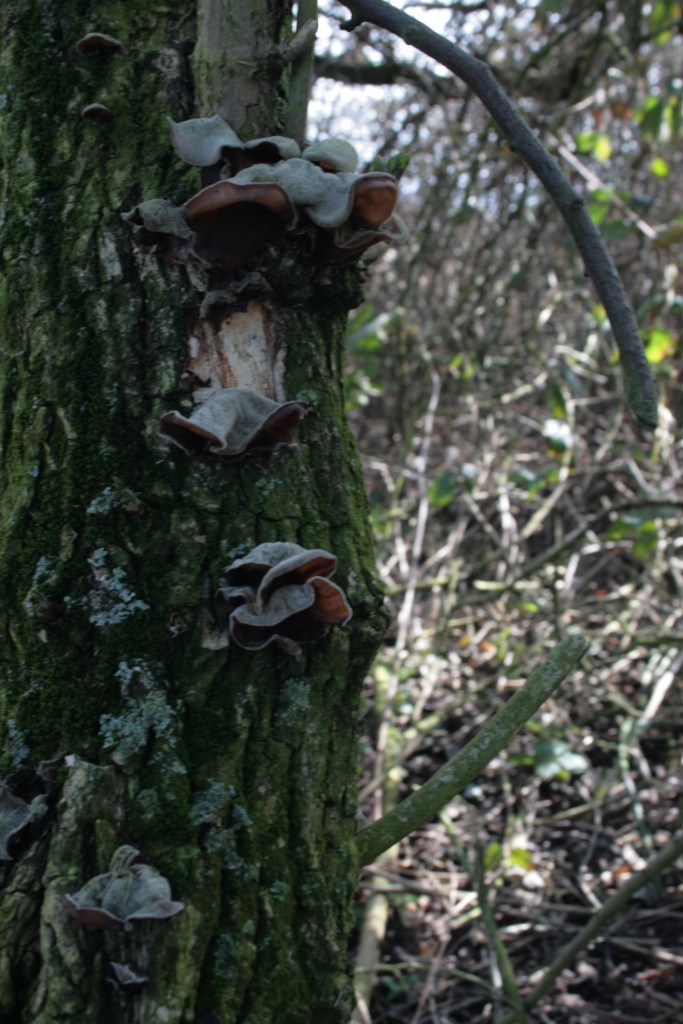
Wood ears, found all year round, are most commonly found on elder trees, either living or dead. They’re a good treasure for finding in spring and winter when other more obvious fungi may be elusive.
Elder bark, with its distinctively, gnarly, furrowed bark, offers a textured contrast to these undulating brown specimens and its a greatly helpful indicator when trying to identify them. Auricularia auricula-judae begin life as cup shaped and smooth before they become elongated and wrinkly giving them their distinct ear-like appearance. They are soft on the outer surface and moist on the inside. I have read that they are attached ‘laterally by a small stalk’ to its host, I have not noticed this but will have to look closer next time! Their colour darkens significantly as they age.
They are widespread and common throughout the globe, and can be found in Ireland, the UK, mainland Europe, parts of Asia and North America.
Cate2, the extensive database run by The Fungus Conservation Trust, shows records for this species as being widespread across Wales, England, the Isle of Man, and the South of Scotland; densely recorded in those areas. Interestingly much more sparsely recorded in the highlands of Scotland, though whether this is due to them being unrecorded or due to them actually being sparse in this area, I am unsure. There are, at time of writing, 10499 records for Auricularia auricula-judae in total on the database, dating from 30/09/1888 on a tree stump in a domestic garden in Staffordshire, and the latest (at time of writing) on the 16/04/2021 by a riverside on a dead branch of an elder in Northumberland.

These wood ears pictured here, are from the unique and interesting site – Rabbit Ings Country Park. On an elder, by the damp side of a body of water on the north of the park, the warden was able to take me right to them, such reliable fruiting bodies as they are. The park is on the site of the former Monkton colliery & Royston Drift Mine and spoil heap, restored to nature by The Land Trust. I had the pleasure of doing some sporadic volunteering here in 2015, before I left the UK. At the time, it was cared for by a couple of passionate, welcoming and community-minded rangers who promoted the park’s biodiversity which included, birds, newts and snakes. I found it to be an inspiring and shining example of the potential for biodiversity and community in reclaimed sites.
I have read that the scientific name is derived from the rumour that Judas of the Christian Bible, was said to have hung himself on an elder tree. I haven’t been able to corroborate how true this is. It would be interesting to look back on elder trees and their presence in Jerusalem 2000 years ago.
Auricularia auricula-judae, Wood Ear, are a fun fungus and in my experience, one of the easiest to identify and it’s even edible. Though I haven’t found one yet that looked appetising!

Basic Profile
Scientific name: Auricularia auricula-judae
Common English names: Wood Ear, Jelly Ear, Jew’s Ear
Size of fruiting body: Up to 8cm across
Spores: 16-18 x 6-8µm, sausage shaped
Gills: None
Edibility: ‘Best in soups or stews, not easily fried’ says Patrick Hardy in his excellent book ‘Mushrooms’.
Lookalikes: Auricularia mesenterica (tripe fungus) is a bracket fungus, described as small, hairy and gelatinous, on stumps and dead wood, not elder; Auricularia fuscosuccinea can look similar, but is not recorded in Ireland or the UK and has a different though significant global spread, it has been proposed for the Red Data List and can be found in tropical areas as well as in Russia and Africa.
On the Red Data List (extinct/critically endangered/endangered/vulnerable/near threatened): No
References:
Cate2 Database, managed and maintained by The Fungus Conservation Trust
Red Data List, British Mycological Society
The Global Fungal Red Data List Initiative
Collins Complete Guide to British Mushrooms & Toadstools, Paul Sterry & Barry Hughes, 2009
Mushrooms and Toadstools of Britain and Europe, Edmund Garnweidner, 1994
Mushrooms, Patrick Hardy, 2013

